
The Best of Everything
Encyclopedia Entry • Films Main
Rain
1932


Critics' Reviews • Our Reviews • Movie Posters • Lobby Cards • Misc. Images • Book
Click here to see photos from the film.
US general release: 10/12/32. (Los Angeles premiere: 9/9/32)
VHS release: 1/25/00 (VCI); 2/27/01 (Image); 3/23/04 (Allied) DVD release: 8/10/99 (Roan); 2/27/01 (Image) Blu-ray release: 9/27/22 (VCI) Cast: Joan Crawford (as "Sadie Thompson"), Walter Huston, William Gargan, Beulah Bondi, Matt Moore, Kendall Lee, Guy Kibbee, Walter Catlett, Ben Hendricks Jr., Fred Howard. Credits: From the play "Rain," adapted by John Colton and Clemence Randolph from the story by W. Somerset Maugham. Screenplay: Maxwell Anderson. Director: Lewis Milestone. Producer: Joseph Schenck. Camera: Oliver T. Marsh. Art Director: Richard Ray. Music: Alfred Newman. Editor: W. Duncan Mansfield. Plot Summary: The pleasures of the flesh confront the discipline of the Lord's teachings in this screen adaptation of W. Somerset Maugham's story Miss Sadie Thompson. Sadie Thompson (Joan Crawford) is a sassy streetwalker who lands in Pago Pago in the South Pacific after an epidemic grounds the ship on which she's booked passage. Sadie's shapely legs, free spirit, and quick wit soon attract the attention of a group of American soldiers stationed on the island; while most are motivated by simple lust, the naive Sgt. O'Hara (William Gargan) falls head over heels for Sadie, thoroughly unaware of her checkered past and shameful profession. Rev. Alfred Davidson (Walter Huston), a fire-and-brimstone preacher bent on bringing salvation to the soldiers, is fully aware of Sadie's occupation and moral code, and is determined to convince her to change her ways. Sadie slowly but surely is softened by Davidson's conviction, but the preacher soon finds himself affected by her sensual presence; O'Hara also learns the truth about Sadie, but hatches his own plan to reform her -- marriage. While a box office failure in 1932, Rain has gone on to become a cult favorite, thanks to Crawford's vivid performance as Sadie and director Lewis Milestone's adventurous visual style. ~ Mark Deming, All Movie Guide
Notes: • Filmed on Catalina Island off the coast of California. • Other famous "Sadie Thompson"s: Jeanne Eagels (1922, stage); Gloria Swanson (1928 silent film); 1935 (Tallulah Bankhead, stage); Rita Hayworth (1953 film). Carroll Baker appeared in a 1970 TV version. • Screenwriter Maxwell Anderson also wrote a radio play that Joan appeared in later in the 1930s: "Mary of Scotland" for the Lux Radio Theater. • Joan's fellow cast members were cool to her during filming. Walter Catlett went so far as to tell her, "Listen, fishcake, when Jeanne Eagels died, Rain died with her." (Joan Crawford: A Biography) • While filming on Catalina Island, Joan usually stayed in her cottage evenings, playing Bing Crosby records over and over, to the annoyance of her fellow cast and crew. (JCB) • Joan's marriage to first husband Doug Fairbanks, Jr., was on the rocks during filming. She often refused to take his calls and was short with him when he sailed out for a visit, claiming he was ruining her concentration. She went into seclusion after the film wrapped in the summer of '32, and a belated honeymoon trip to Europe proved fruitless. The couple were officially divorced 7 months after Rain's release. • Joan discovered she was pregnant during filming and told Fairbanks that she had slipped on the deck of a ship while shooting, losing the baby. (Last Word)
|
Mollie Merrick in the Los Angeles Times (September 10, 1932) Shock of Paul Bern’s suicide and the tragic circumstances surrounding Jean Harlow cut social life to a minimum and will undoubtedly dim the most brilliant opening scheduled for the season: “Rain” having its world premiere at Grauman’s Chinese Theater tonight.
Cancellations
from friends of the producer have been rolling in – most of them, not
feeling up to the strain of attending a gala premiere on the same day
they attend the services for one of the most beloved and respected
executives the industry has ever known.
“Rain,” previewed for a professional audience, left them gasping for breath at the frankness of its adherence to Colton’s ironical concept of Davidson, the missionary. Members of the Hays offices looked a bit somber and thoughtful as they filed out but admirers of Lewis Milestone, that ace of directors, were grinning broadly at this latest coup of the brilliant “Milly,” who is recognized as one of the world’s aces of directorial work. Despite Joan Crawford’s apt impersonation of the colorful Sadie Thompson – despite her obvious endeavors to get away from Jeanne Eagels’ concept of this role – and an admirable attempt it must be said – and despite Walter Huston’s
marvelous and restrained portrayal of a role which could easily have
been thrown into hysteria, the picture “Rain” remains a director’s
triumph.
I am not certain it should be a triumph of technique, of camera and the very clever montage which goes to make up its many and interesting angles. From my point of view, the director who buries himself completely in the story is perhaps the greatest virtuoso. But
Lewis Milestone was working with material familiar to motion-picture
audiences. He was working in fields moviegoers have come to be
cognizant of with Gloria Swanson and the picture “Sadie Thompson,” as written by Somerset Maugham.
I
n this case, where the drama is such a well-known thing, it is
legitimate for the director to point his moments with the expert
technique for which Milestone is famous.
The montage of the rain which falls with the exquisite harmony of a tone poem alone is a coup. The camera shots which are unforgettable in their beauty – the lyrical reiteration of the hauling-in of the nets – the first time with their cargo of glittering silvery fish, the last time with their grisly human cargo of the sodden remains of the remorseful missionary – represent the highest the technical end of motion pictures can give. William Gargan’s
portrayal of Sgt. O’Hara may go unnoticed because it is so sincere. We
pay a price for such sincerity – the audience may forget this is an
actor, not a Marine. His choice for the role is singularly felicitous
and his work one of the exquisitely fine things the screen has given us
of late. I have already mentioned Walter Huston as Davidson. He was as
consistent with his portrayal of this character as he always is – but
he played it with a restraint which may bring censure from those who
prefer blood and thunder in their impersonations.
Guy Kibbee as Joe Horn is unforgettable and his rendition of Nietzsche’s lines from "Zarathustra” almost concept one for the loss of Sadie’s immortal philosophy, “Sometimes I feel sorry for the whole world.” As
for Joan Crawford, she is excellent though not always consistent. The
role of Sadie is a handicap rather than an opportunity for any actress
in that it puts an artist up against the Jeanne Eagels portrayal, which
was perfection.
Jeanne Eagels could say more with those twitching calves than a whole world of actresses can do with make-up and costuming and original versions. The role of Sadie Thompson should have died with Jeanne Eagels. But if it must be resuscitated, Joan Crawford gives a brave and artistic concept of a slightly different girl. Beulah Bondi read her lines with a world of dry humor – Fate didn’t give her that righteous spine of Blanche Frederici, but she made the most of her opportunities, and Matt Moore as the doctor kept his role just where it should be – a purely passive one.
Mordaunt Hall in the New York Times (October 13, 1932) Sadie Thompson Again. W. Somerset Maugham's tarnished heroine, Sadie Thompson, who was impersonated on the stage by the late Jeanne Eagels and in a silent film by Gloria Swanson, is now to be seen at the Rivoli in the form of Joan Crawford in an audible pictorial conception of the play "Rain." This production was made on Catalina Island Beach, which serves admirably for the South Seas bit of land known as Pago Pago. Maxwell Anderson arranged the adaptation from the dramatic work and Lewis Milestone was entrusted with the direction. Besides Miss Crawford, there are in the cast, among others, Walter Huston, Guy Kibbee, Beulah Bondi, Matt Moore and William Gargan. With such obvious advantages, a far better picture than has been made was to be expected. The photography and the scenic effects are splendidly done. There is the impression of the incessant rain and also the sticky heat in the comfortless trading post run by Joe Horn. Moreover, in several respects the present film contains episodes that were dodged in its mute predecessor. But here, there is much that goes against the grain, either when matters are overemphasized or when the persons involved are too zealous to reveal their characteristics. Mr. Huston is at his worst as the Rev. Davidson, the bigoted preacher. He walks as if he had spent years as a private in the Prussian Army, and in a sequence the usually sagacious Mr. Milestone has him repeat the Lord's Prayer four times. The psychology is forced and erroneous in other characters, including Sadie Thompson. She, with sparkling bangles on her wrists, openwork stockings and slippers, is anxious all should know her profession. When she wilts before Davidson it no longer seems to be plausible. Then the marine, Sergeant O'Hara, is much too naïve for one of the contingent who sing loudly of it taking "ten thousand gobs to lick one sick marine." He is more like a lovelorn hero of early film days. Beulah Bondi as Mrs. Davidson leaves nothing to the imagination in the tone in which she refers to her supposedly earnest husband. Like Mr. Huston, she loses the spirit of the rôle. Naturally, all who intend going to see this picture want to know about Joe Horn, who was acted in the play by Rapley Holmes. Here the adipose and bibulous trader is interpreted by Guy Kibbee, who does capital work, but he has not the same opportunity as his stage colleague had. He does more to help this film than any of the other players, but at the same time it should be set forth that for the brief time that Walter Catlett is beheld he makes the most of the part of Quartermaster Bates, and Matt Moore is easy and natural as Dr. MacPhail. The dramatic effect of the finding of the body of the Rev. Davidson has been spoiled and the lines, coupled with the way in which Mr. Huston speaks them, so weakened several sequences that many in the crowded theatre giggled and laughed when they should have been held in silence. Motion Picture Herald (1932): Because the producers have made such a strong attempt to establish the stern impressiveness of the story, it is rather slow. In its drive to become powerful, it appears to have lost the spark of spontaneity....Joan Crawford and Walter Huston are satisfactory.
Abel Green in Variety (1932): It turns out to be a mistake to have assigned the Sadie Thompson role to Miss Crawford. It shows her off unfavorably. The dramatic significance of it all is beyond her range.... [Director] Milestone tried to achieve action with the camera, but wears the witnesses down with words. Joan Crawford's get-up as the light lady is extremely bizarre. Pavement pounders don't quite trick themselves up as fantastically as all that. In commercial favor of Rain is the general repute of the theme and Miss Crawford's personal following, but the finished product will not help either. |
If you've seen Rain and would like to share your review here, please e-mail me. Include a photo or avatar of yourself to accompany your review, a star-rating (with 5 stars the best), and any of your favorite lines from the film.
|
Rating:
Joan Crawford did not like her performance in Rain, a 1932 loan-out from MGM to United Artists. She was experiencing the dissolution of her marriage with Doug Jr during shooting of the film, which may have soured her assessment. Comparisons in the press with Jeanne Eagels and Gloria Swanson---famous for stage and silent versions of this story, respectively---may also have detracted from Joan’s confidence in her take on Sadie Thompson, a good-time girl stranded in Pago Pago with fellow travelers, including an imperious missionary (Walter Huston, who is great here, just like in every film of his that I've seen.) and his prudish wife (Beulah Bondi).
The conflict revolves around the missionary, Reverend Davidson, and his desire to make Sadie a pet project for eternal damnation or salvation: He doesn't seem to care which. Even though this film is pre-Code, it still pussyfoots around salacious aspects, such as what exactly Sadie does for a living, and the true nature of her interactions with the Reverend. I found reading the original short story a bit more enlightening: https://fountainheadpress.com/expandingthearc/assets/maughamrain.pdf
Notes of interest: Although largely spectators to the struggle between Joan/Sadie and Huston/Davidson, Rain has a great supporting cast. Guy Kibbee (who also appeared with Joan in 1931's Laughing Sinners) is the owner of the hotel where the travelers wait to clear quarantine. Beulah Bondi (who played Mrs. Andrew Jackson in 1936’s The Gorgeous Hussy) as Mrs. Davidson, is also fabulous. I always thought of Mrs. Davidson as the real villain, as she is continually exhorting the Reverend in his toils against sin---and against Sadie. Rain was shot on Catalina Island, a popular location back in the day when Hollywood needed a tropical island setting. The local museum in Avalon has a section dedicated to movies shot on Catalina, including Rain. Rain is derived from a short story by Somerset Maugham, noted British writer, who also provided the source material for one of Joan’s earliest movies, The Circle (1925). One wrinkle not in Maugham's original short story is a romance between Sadie and a Marine stationed on the island, played by William Gargan. He’s OK here. Any number of handsome B-list actors could have filled in. Rain is directed by Lewis Milestone, best known for directing and winning an Oscar for All Quiet on the Western Front, 1930. The photography is excellent. You literally feel the heat and humidity oppressing Sadie. A fitting allegory for her oppression by Reverend Davidson. Oliver T. Marsh, who served in this capacity on a bunch of Joan films, gets the credit for cinematography.
As mentioned elsewhere on BOE, fellow cast member Walter Catlett is purported to have said to Joan: "Listen, fishcake, when Jeanne Eagels died, Rain died with her." (Catlett plays the ship's quartermaster; Eagels was a Broadway shooting star, now largely forgotten, her career cut short in 1929 by addictions.) With respect to Mr. Catlett, if any version of Sadie Thompson remains in the public's consciousness, I think it is Joan's.
Thanks to the lapse of the movie's copyright, copies of Rain are abundant on YouTube. Rain is not a classic, and Joan's performance is not great, but I think Joan---as usual---is being tough on herself. I still slightly prefer the Gloria Swanson version, since I prefer my movies unburdened by talk, and Ms. Swanson is one of the few actresses who rivals Joan in my pantheon of movie divas. But Joan gives a gritty performance, her conflict with the Reverend is compelling, and the supporting cast is very good. And, at a tad over an hour and a half, Rain is well paced.
Rating:
Joan's co-star in Rain, Walter Catlett, told her outright while filming, "Listen, fish-cake, when Jeanne Eagels died, Rain died with her." Although critics at the time, and Joan herself, tended to agree, these negative opinions were not to remain the standard.
Miss Crawford was called upon to remake Rain at United Artists. It is a film based on a short story by Somerset Maugham, about a bad girl stuck in the tropics who ends up fighting off not the natives or the mosquitoes but the Reverend Davidson. Miss Eagels made the role almost legendary after 648 Broadway performances, and Gloria Swanson later skipped around in the 1928 silent version, which has survived. In 1953, wonderful Rita Hayworth remade Rain in Technicolor and 3D, which the critics loved. I, however, am partial to Miss Crawford’s 1932 version because it’s raining the whole damn time and you get a true sense of the island Pago Pago: the awful climate, the missionaries, the natives, and the sailors passing through. Miss Hayworth’s version is too colorful, and the camera steps out a lot from the original play, and of course she dances and sings. Joan just plays a phonograph perfectly! At the time of Joan’s remake, she was only concerned about the ghosts of Misses Eagels and Swanson and with wanting to improve her career with a classic role. The critics of the time got it all wrong; viewers for the past 50 years have found Miss Crawford’s performance to be one of her best, and I agree. She is bold and forthright; she is Sadie--just wearing a different hat from Swanson's. The only character from the short story "Rain" to play the role as written was the superb Beulah Bondi (who received a BSA nomination for The Gorgeous Hussy in 1936): the way Maugham described her--the voice, the eyeglasses--she has got it down; as irritating as she is, she played it as he wrote it. In the story, Guy Kibbee’s character, who ran the general store and rented rooms, was a half-caste and fully tattooed. His character is the most fun in the film, and his island wife and brood of kiddies running around bring a little comedy. Miss Crawford was apparently treated well by him; their scenes had a special feeling about them--he was on Sadie’s side, even though he could only offer her a can of either beans or tamales. In the book, the doctor--played by Matt Moore in the film--was described like he should have been played by Slim Somerville!! He also has more time in the book than in the movie. His wife could have been played by anyone, but Kendall Lee gave it her Mary Astor best shot for the small time she was allotted, which was mostly spent hiding her face in disgust from the raw Sadie and protecting Mrs. Davidson. Walter Huston, whose character "Reverend Davidson" is also described much differently in the book, still captured the coldness and preciseness of the bigoted, tortured Reverend. The scenes between him and Miss Crawford are convincing and have a lot of power. If Rain were remade today, religious groups or fanatics would have a fit! That’s why this Crawford 1932 version is the best: the Production Code was not as strict yet, and the film got away with showing exactly who Sadie was and what Reverend Davidson did to her. Mr. Huston should have been nominated--he gives one powerful performance! Rain cameraman Oliver T. Marsh, a favorite of Joan’s, captures the dingy and depressing mood of the island. Joan said later that she did not get along with director Lewis Milestone (All Quiet on the Western Front, 1930); both Joan and Milestone felt her interpretation and range were wrong. But probably only because Joan’s public was not ready for her to have her Of Human Bondage Bette Davis moment. At the time, Rain and its dialogue were just too shocking for them--that’s what really scared them, the truthful, honest dialogue. Milestone does give Joan a clever entrance, when he introduces us to Sadie as a hoydenish sweetie. Editor Duncan Mansfield understood what he was doing! Maugham describes Sadie as "plump and fat"—well, no actress ever appeared that way in any spoof or film role of Miss Thompson! Miss Crawford’s get-up is not Jean Louis or Adrian, but what she wears works; it goes with Sadie’s fun-loving, candid character. She might not have any class, but her heart is pure gold. Miss Crawford gives us one of her best performances--and with no recognition from her Hollywood of the time. I just wish she had not been so devastated by the results and the disappointment of her fans because her Sadie would be a fighter for women today, a role model. The difference in the film is that Sadie leaves with her handsome boyfriend, played by William Gargan, for a happy ending with a beautiful poignant last line that only Crawford could say: “I feel sorry for everybody in the whole world." In the short story, the boyfriend does not get much play, nor does Walter Catlett’s character, and the story ends with Sadie putting on her phonograph yelling, “Pigs! Pigs! You’re all the same--Dirty Pigs!” right after she spits toward Mrs. Davidson! The phonograph ends up being an important character in the film and is symbolic of Sadie’s feelings and spirit. I like the Hollywood happy ending. The short story leaves you knowing Sadie will probably not find happiness. And I recommend watching all three film versions, if at all possible. To see that Rain did not, in fact, die with Jeanne Eagels. Rather, it actually got a new life with Miss Crawford’s modern, real performance.
Rating:
The rain starts with a single drop that descends into an incessant deluge in this 1932 film adaptation of W. Somerset Maugham's short story set on the South Seas island of Pago-Pago. In Maugham's story, the rain is "unmerciful and somehow terrible; you felt in it the malignancy of the primitive powers of nature."
This film version of the story, already a big stage hit for Jeanne Eagels as well as a 1928 silent vehicle for Gloria Swanson, remains true to Maugham's exploration of the eternal conflict between the ominous "primitive" and the equally ominous forces of "civilization."
The Reverend Davidson (an appropriately angular and glittery-eyed Walter Huston) represents civilization here, an entity mightily offended by the anarchic spirit of both the South Seas natives and of Miss Sadie Thompson (Joan), a prostitute and fellow passenger on the boat that is forcibly waylaid on Pago-Pago because of a cholera outbreak on the island the ship was destined for.
Once necessarily settled into a cheap hotel for a fortnight, the pounding of the native drums is as irritating to Davidson as the raucous ragtime emanating from the gramophone Sadie sets up in her room while she entertains American sailors to pass the time.
After years of missionary work, Davidson's used to bullying the natives (in the story, Davidson says, "We had to make sins out of what they thought were natural actions"), but Sadie is quite another "savage." She jeers and rolls her eyes in the face of Davidson's disapproval, determined simply to mind her own business and to pass the time while waiting for the next boat to sail.
Her "live and let live" attitude is mirrored by the hotel owner---a geezer who first came to the South Seas specifically to avoid the "Reformers" newly active in the States. He's long since gone native, marrying a local and spending his time rocking and drinking on the front porch, quoting Nietzsche ("Everything goeth, everything returneth...") and grousing about said Reformers: "They'll break your back to save your soul" and "They have lots of misdirected energy."
The energy Reverend Davidson directs toward Sadie quickly becomes obsessive. After breaking up her initial party, he lectures her about salvation---and how its only alternative is destruction. She's at first openly contemptuous, but soon obligingly softens and apologizes to him for causing trouble, promising to stay out of his way. Too late. His wheels of mercy are already in motion and he's reported her to the island's governor, determined to have her not just banished to her room or from Pago-Pago, but instead sent back to San Francisco, where she faces a sure jail sentence for prostitution.
Sadie's outraged reaction to Davidson's intransigence is one of Joan's finest and most goose-bump-raising scenes in the movie---her Sadie is a wild, cornered animal who has to be forcibly dragged away from Davidson before she physically attacks him. Onscreen onlookers are shocked---not at Sadie's reaction, but at Davidson's "harsh and tyrannical" behavior.
The Reverend's certitude soon begins to wear Sadie down psychologically, though. She starts to get spooked and to mentally unravel, envisioning the Reverend as all-powerful: "His eye sees right into you." Her instability isn't helped by the constant onslaught of the unnerving rain, or a native's telling her that the Reverend is a "witch doctor."
In Joan's tour-de-force scene, her Sadie finally confronts the Reverend on the staircase in a last-ditch attempt to beg him for mercy. When he continues to insist that she needs to be punished, she lashes out: "Your god and me'll never be shipmates. You can tell him for me that Sadie Thompson is on her way to HELL!" As he towers over her and repeatedly recites the Lord's Prayer, her brazenness finally breaks---
The energy of her outrage doesn't quite dissipate, though, but rather transforms---complicatedly---into the energy of almost equally avid submission. While her subsequent scenes, as the "reformed" Sadie, find Joan in drab garments and scrubbed-down face and very still movements, the intense glow in her eyes never subsides. Even when she's numbly reciting, "Mr. Davidson says it doesn't matter if I'm innocent or guilty...I've got to go back and be punished."
Along with the inner intensity and complexity that Joan brings to the role, the camera work of Oliver Marsh is equally masterful. From our first look at Sadie with the staccato slap-slap-slap-slap of her bejangled wrists and beribboned shoes (shots echoed exactly at the end of the film) to her post-salvation saintly glow to the innovative camera angles (on the stairs, as she's looking through the food pantry) to the fluidity of the camera movement panning around her on the porch (not to mention the various artistically symbolic shots of the rain), Marsh's eye is stunning and adept, perfectly atuned to the both sensually languid and ominous story being told.
"Rain" was received poorly by both critics and the public of the time (the latter, particularly, referring to Joan's performance as "vulgar and cheap"). Joan herself continued to dislike the film for decades afterward. ("I don't understand, to this day, how I could have given such an unpardonably bad performance.") Despite the dismissal, Joan manages to intensely and brilliantly capture the nature of the Primitive---in all of its radiant, beautiful, terrible, and ultimately overpowering glory.
Chris Hughes (February 2007) Don't listen to any houhy about this not being a good film. From the moment Joan first appears onscreen as Sadie she is completely captivating. True, the character is strangely overdone and exaggerated, but it works somehow and the soul of Sadie shines through Joan's performance. And it is a sad and powerful performance. The whole movie is slightly skewed, like a good Orson Welles movie, but it works and it is the unusual flavor of the movie that I like the best. Why would you want it to be like every other cliche Hollywood movie? There are plenty of nice little character touches in the movie, the innkeeper and his rotund Polynesian wife. Very strange and wonderful. The Island people are portrayed in a respectful and realistic way. Not the usual Hollywood bologna about native people. Walter Huston is superb. He had me believing his holy gospel by the end of the picture!! And when the old Sadie returns in the end you realize that you really missed and loved her. This is an unusual and original film and Joan Crawford's Sadie is an unforgettable character. And finally, the Somerset Maugham story really has a clear and timeless message for us all: Don't judge other people too harshly, they are all doing the best they can. We are all human with shortcomings and frailties. Enjoy the present and don't worry too much about being "good". In the words of John Lennon, "whatever gets you through the night, its alright, its alright."
Louis (March 2006)
Rain is actually one of my favorite Crawford films. Firstly her appearance in this film knocks you on your ass; she's way overdone even for Crawford and it makes you love her even more because you can tell that although Sadie is outlandish and very loud, on the inside she's just a little girl looking for love in all the wrong places. Another great thing about Crawford in this film is how raw her acting is; she hasn't quite become that Joan we all know and love. Although this film was a flop 74 years ago I think every Crawford fan should give up 2 hours of their life and sit down with a glass of scotch and watch this steamy, saucy tale of little girl lost.
Paul (June 2005) I must admit that this was a film that I'd been curious to see for quite a long time, simply because it is widely regarded as Joan Crawford's first flop. I put the DVD in and then made myself watch it with a completely blank and objective viewpoint. Personally, given the roles that she had portrayed up until that time she does a remarkable job and it is a remarkable movie when you take into account that it was made in 1932. Although I'm not sure, I would guess that this film was made before the Hays code went into effect, as RAIN does not have a traditional happy ending and it shows the underlying hypocrisy of fervent religious zealots. That was pretty racy territory for the time. In fact, the innkeeper who spent his nights reading and quoting Nietzsche was a brilliant touch. I highly recommend this movie. |
Original 1932 release
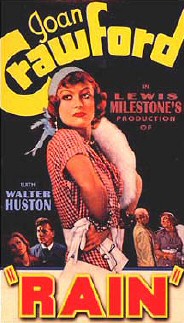
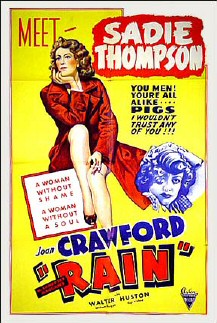
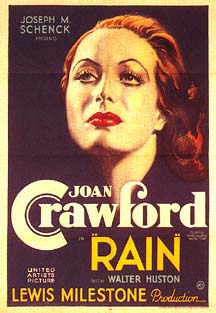
1939 re-release (Atlantic Pictures, left, and Astor Pictures, right)
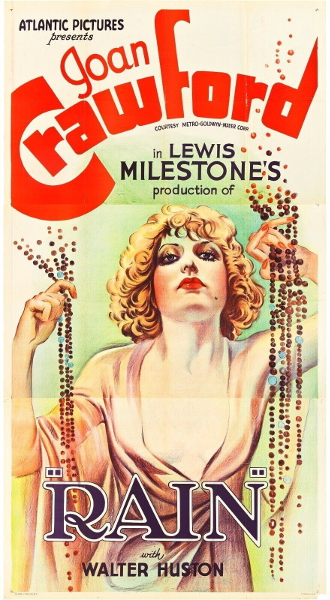


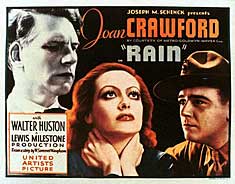

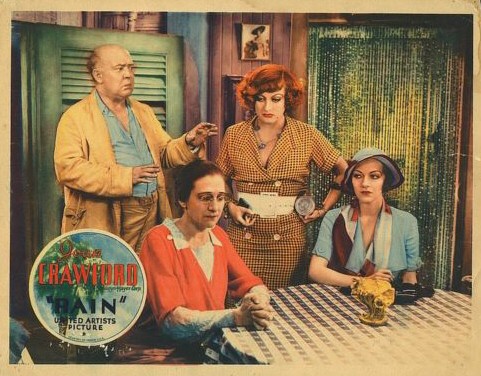



1939 U.S. Re-release (Atlantic Pictures)
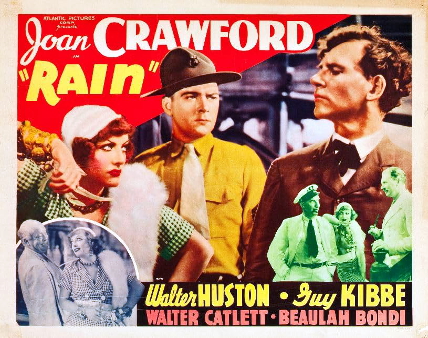

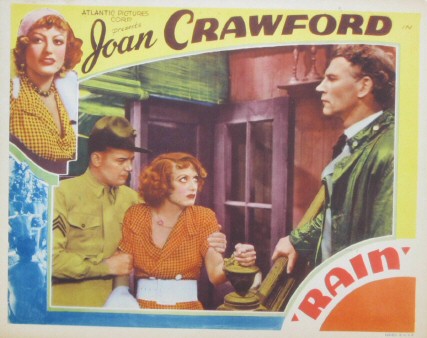
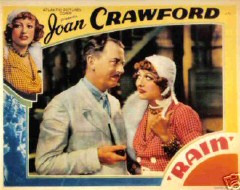
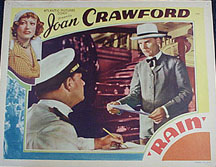
Above: Program from Grauman's World Premiere. Click photo to see larger pages.
Above: Complete United Artists pressbook. Click either page to see legible enlargements of all pages.
Below: 2-page trade ad from the UK (Kinematograph Weekly, 10/27/32).
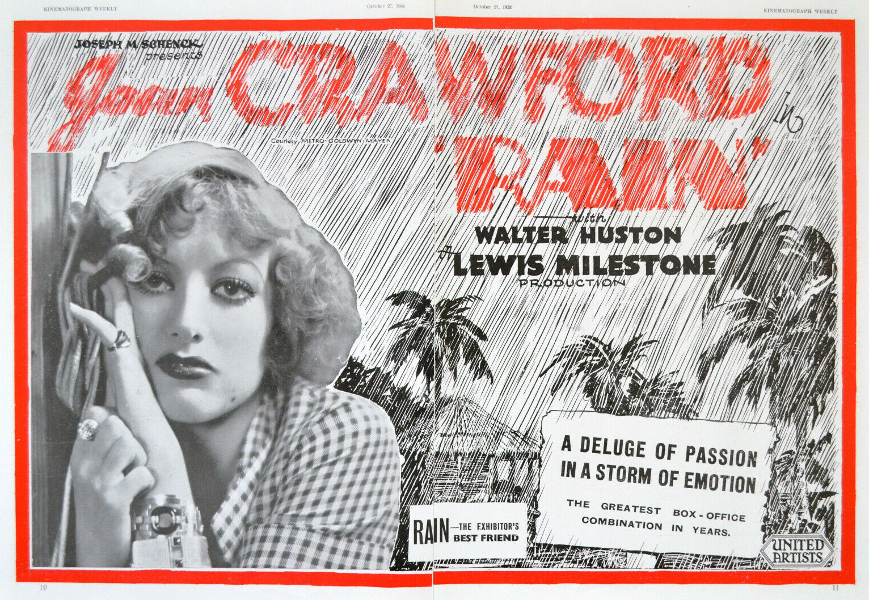
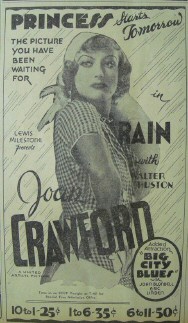
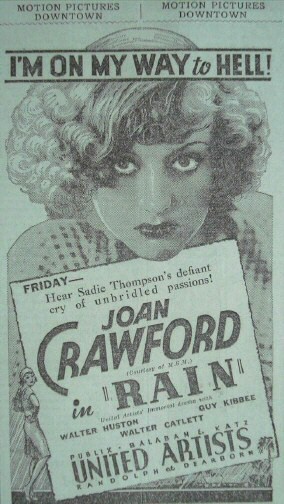

Above: Newspaper ads from Montreal Daily Star, Chicago Tribune, and San Francisco Chronicle.
Below: Heralds (cities unknown).

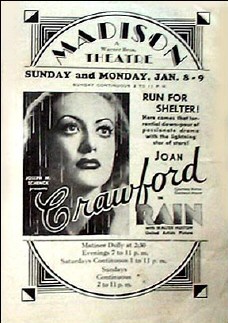
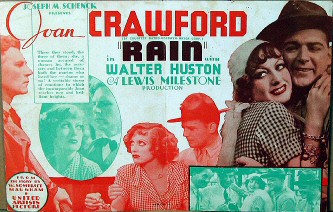
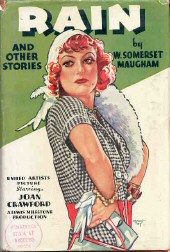
1932
movie tie-in edition. The collection was originally published by W. Somerset Maugham
in 1921
under the title "The Trembling of a Leaf."
The Best of Everything